Hospital Information System: Systems Development and Requirements
VerifiedAdded on 2023/01/19
|13
|3207
|64
AI Summary
This report discusses the development and requirements of a Hospital Information System (HIS) for efficient management of healthcare data. It covers the approach to systems development, systems requirements, cost benefit analysis, project schedule, system information requirement investigation techniques, and reflections and conclusions.
Contribute Materials
Your contribution can guide someone’s learning journey. Share your
documents today.
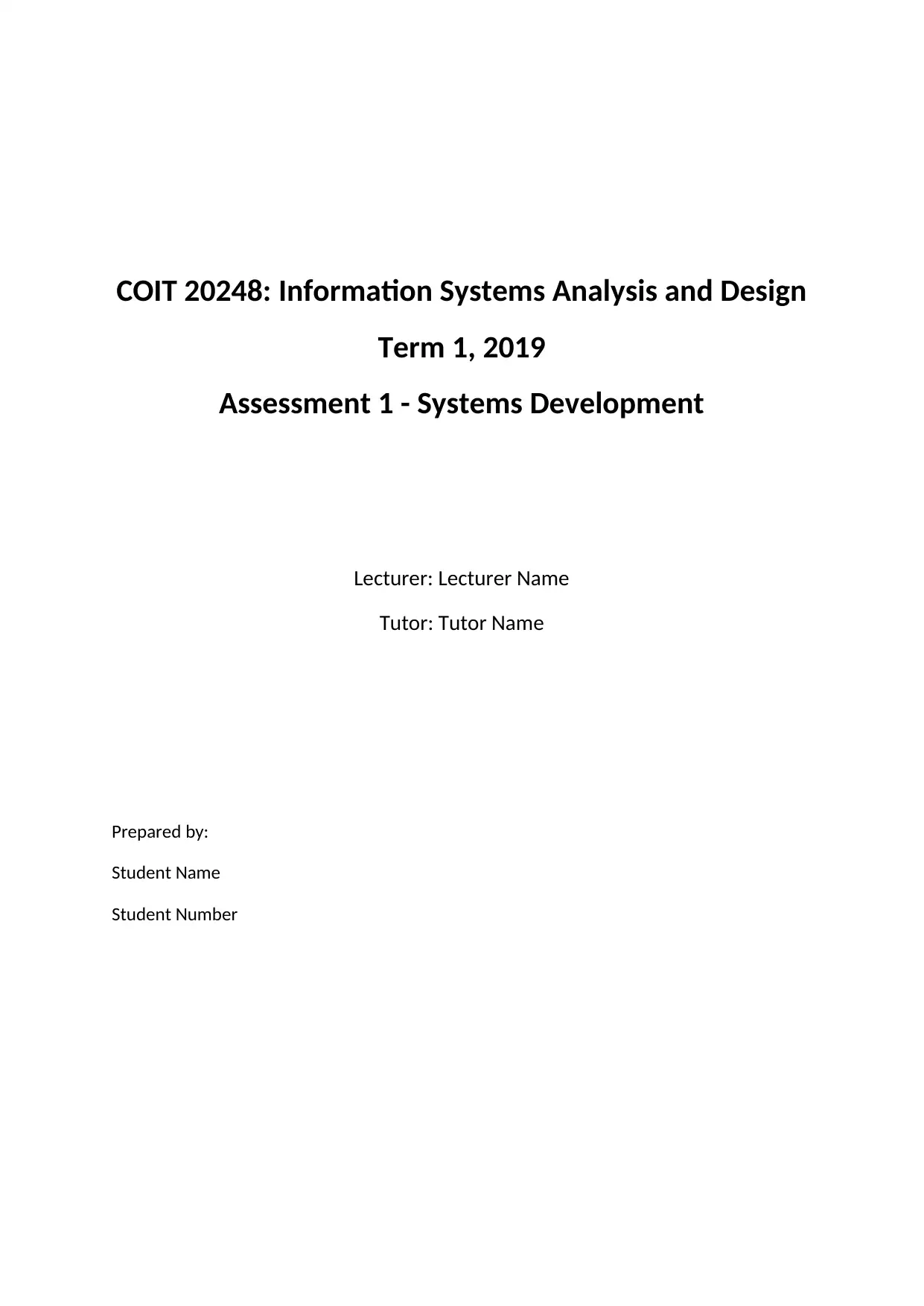
COIT 20248: Information Systems Analysis and Design
Term 1, 2019
Assessment 1 - Systems Development
Lecturer: Lecturer Name
Tutor: Tutor Name
Prepared by:
Student Name
Student Number
Term 1, 2019
Assessment 1 - Systems Development
Lecturer: Lecturer Name
Tutor: Tutor Name
Prepared by:
Student Name
Student Number
Secure Best Marks with AI Grader
Need help grading? Try our AI Grader for instant feedback on your assignments.
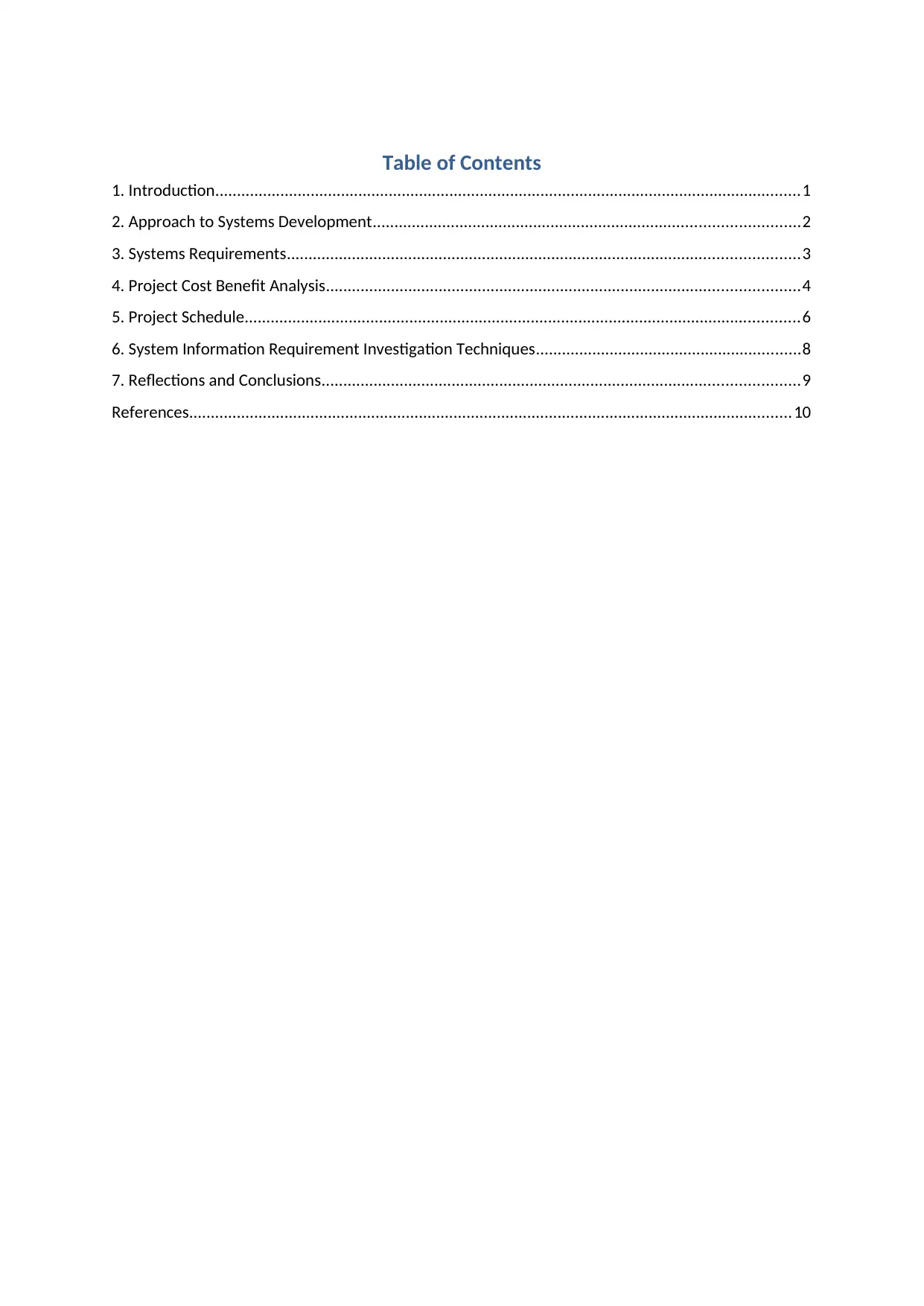
Table of Contents
1. Introduction.......................................................................................................................................1
2. Approach to Systems Development..................................................................................................2
3. Systems Requirements......................................................................................................................3
4. Project Cost Benefit Analysis.............................................................................................................4
5. Project Schedule................................................................................................................................6
6. System Information Requirement Investigation Techniques.............................................................8
7. Reflections and Conclusions..............................................................................................................9
References...........................................................................................................................................10
1. Introduction.......................................................................................................................................1
2. Approach to Systems Development..................................................................................................2
3. Systems Requirements......................................................................................................................3
4. Project Cost Benefit Analysis.............................................................................................................4
5. Project Schedule................................................................................................................................6
6. System Information Requirement Investigation Techniques.............................................................8
7. Reflections and Conclusions..............................................................................................................9
References...........................................................................................................................................10
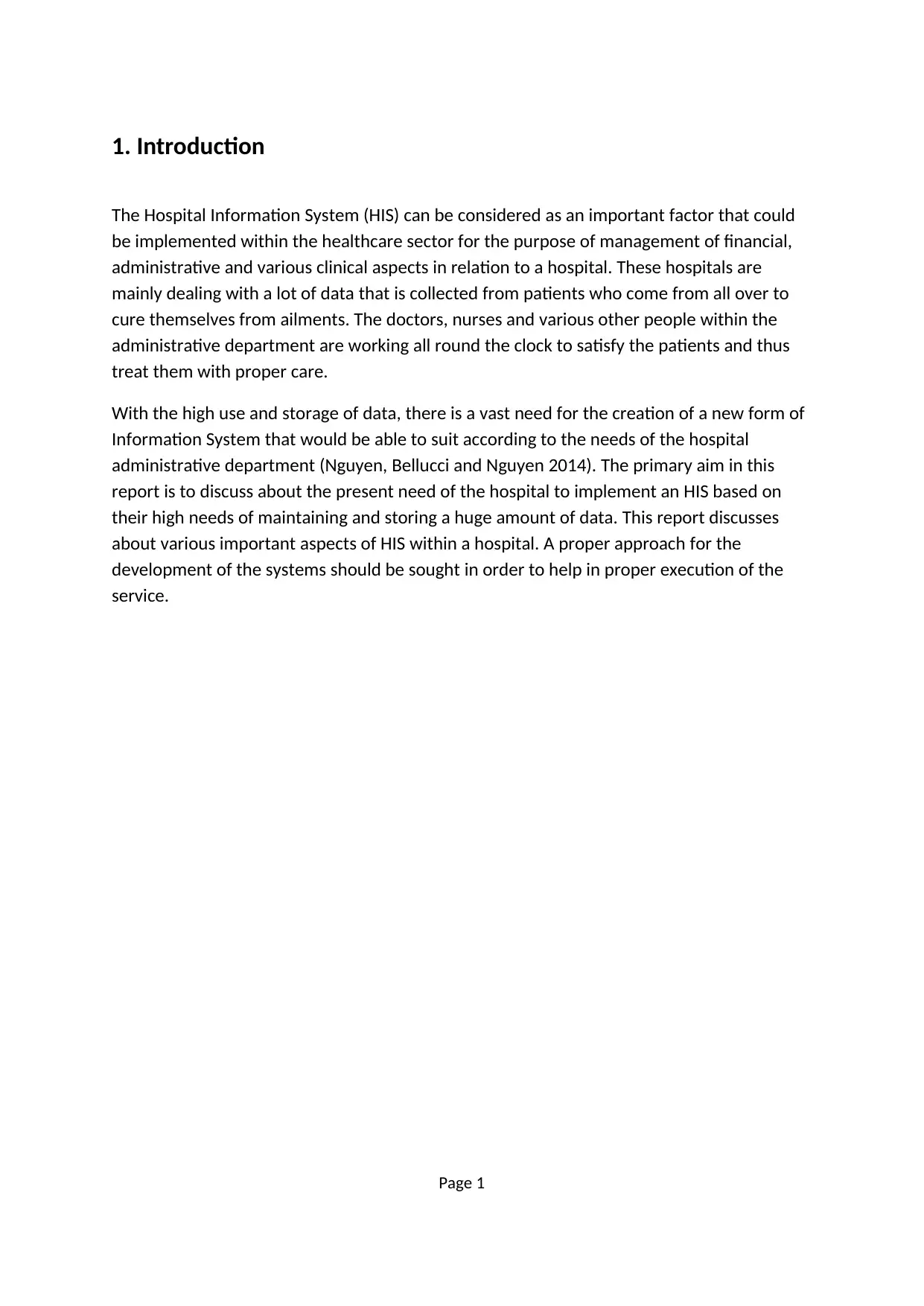
1. Introduction
The Hospital Information System (HIS) can be considered as an important factor that could
be implemented within the healthcare sector for the purpose of management of financial,
administrative and various clinical aspects in relation to a hospital. These hospitals are
mainly dealing with a lot of data that is collected from patients who come from all over to
cure themselves from ailments. The doctors, nurses and various other people within the
administrative department are working all round the clock to satisfy the patients and thus
treat them with proper care.
With the high use and storage of data, there is a vast need for the creation of a new form of
Information System that would be able to suit according to the needs of the hospital
administrative department (Nguyen, Bellucci and Nguyen 2014). The primary aim in this
report is to discuss about the present need of the hospital to implement an HIS based on
their high needs of maintaining and storing a huge amount of data. This report discusses
about various important aspects of HIS within a hospital. A proper approach for the
development of the systems should be sought in order to help in proper execution of the
service.
Page 1
The Hospital Information System (HIS) can be considered as an important factor that could
be implemented within the healthcare sector for the purpose of management of financial,
administrative and various clinical aspects in relation to a hospital. These hospitals are
mainly dealing with a lot of data that is collected from patients who come from all over to
cure themselves from ailments. The doctors, nurses and various other people within the
administrative department are working all round the clock to satisfy the patients and thus
treat them with proper care.
With the high use and storage of data, there is a vast need for the creation of a new form of
Information System that would be able to suit according to the needs of the hospital
administrative department (Nguyen, Bellucci and Nguyen 2014). The primary aim in this
report is to discuss about the present need of the hospital to implement an HIS based on
their high needs of maintaining and storing a huge amount of data. This report discusses
about various important aspects of HIS within a hospital. A proper approach for the
development of the systems should be sought in order to help in proper execution of the
service.
Page 1
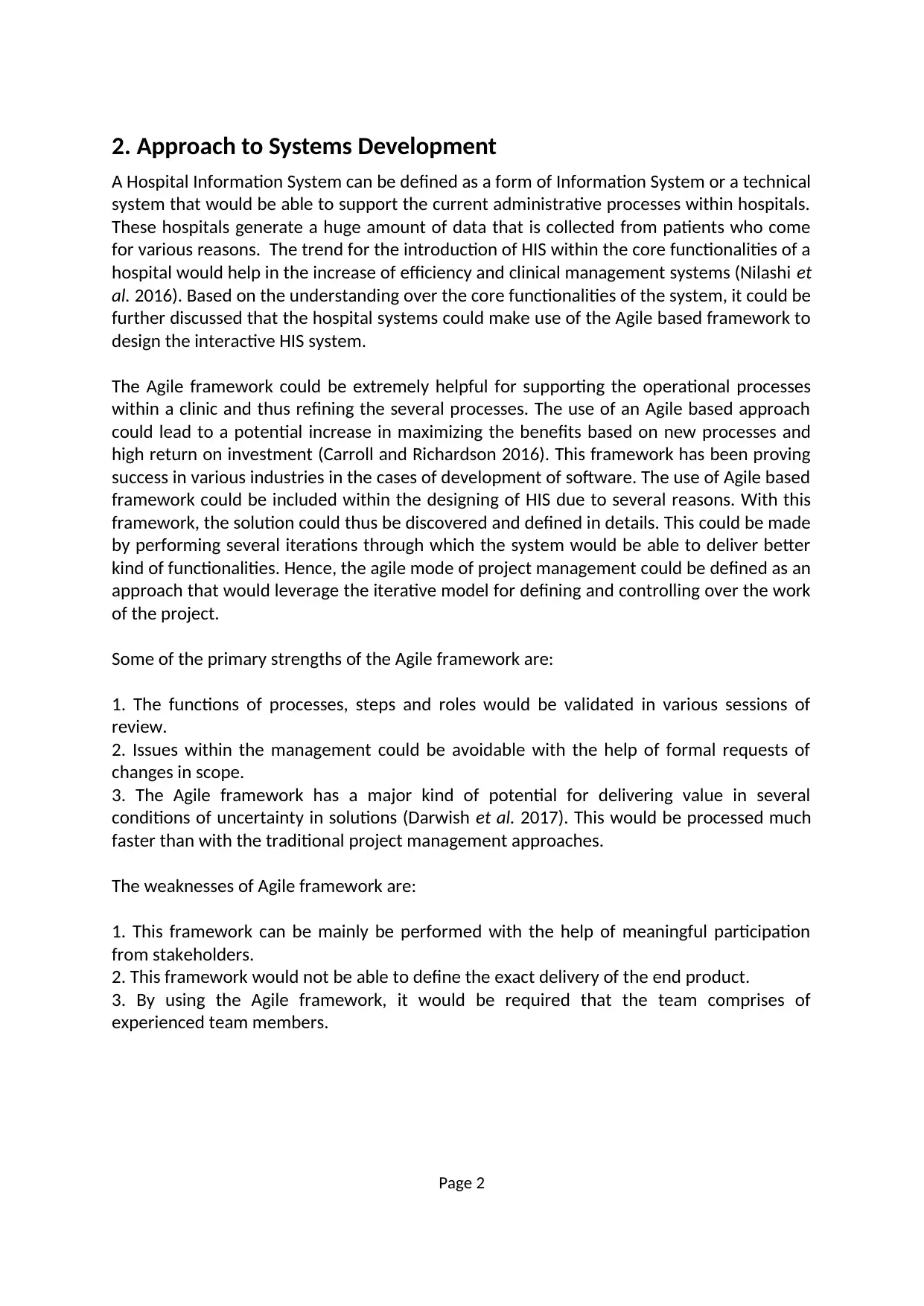
2. Approach to Systems Development
A Hospital Information System can be defined as a form of Information System or a technical
system that would be able to support the current administrative processes within hospitals.
These hospitals generate a huge amount of data that is collected from patients who come
for various reasons. The trend for the introduction of HIS within the core functionalities of a
hospital would help in the increase of efficiency and clinical management systems (Nilashi et
al. 2016). Based on the understanding over the core functionalities of the system, it could be
further discussed that the hospital systems could make use of the Agile based framework to
design the interactive HIS system.
The Agile framework could be extremely helpful for supporting the operational processes
within a clinic and thus refining the several processes. The use of an Agile based approach
could lead to a potential increase in maximizing the benefits based on new processes and
high return on investment (Carroll and Richardson 2016). This framework has been proving
success in various industries in the cases of development of software. The use of Agile based
framework could be included within the designing of HIS due to several reasons. With this
framework, the solution could thus be discovered and defined in details. This could be made
by performing several iterations through which the system would be able to deliver better
kind of functionalities. Hence, the agile mode of project management could be defined as an
approach that would leverage the iterative model for defining and controlling over the work
of the project.
Some of the primary strengths of the Agile framework are:
1. The functions of processes, steps and roles would be validated in various sessions of
review.
2. Issues within the management could be avoidable with the help of formal requests of
changes in scope.
3. The Agile framework has a major kind of potential for delivering value in several
conditions of uncertainty in solutions (Darwish et al. 2017). This would be processed much
faster than with the traditional project management approaches.
The weaknesses of Agile framework are:
1. This framework can be mainly be performed with the help of meaningful participation
from stakeholders.
2. This framework would not be able to define the exact delivery of the end product.
3. By using the Agile framework, it would be required that the team comprises of
experienced team members.
Page 2
A Hospital Information System can be defined as a form of Information System or a technical
system that would be able to support the current administrative processes within hospitals.
These hospitals generate a huge amount of data that is collected from patients who come
for various reasons. The trend for the introduction of HIS within the core functionalities of a
hospital would help in the increase of efficiency and clinical management systems (Nilashi et
al. 2016). Based on the understanding over the core functionalities of the system, it could be
further discussed that the hospital systems could make use of the Agile based framework to
design the interactive HIS system.
The Agile framework could be extremely helpful for supporting the operational processes
within a clinic and thus refining the several processes. The use of an Agile based approach
could lead to a potential increase in maximizing the benefits based on new processes and
high return on investment (Carroll and Richardson 2016). This framework has been proving
success in various industries in the cases of development of software. The use of Agile based
framework could be included within the designing of HIS due to several reasons. With this
framework, the solution could thus be discovered and defined in details. This could be made
by performing several iterations through which the system would be able to deliver better
kind of functionalities. Hence, the agile mode of project management could be defined as an
approach that would leverage the iterative model for defining and controlling over the work
of the project.
Some of the primary strengths of the Agile framework are:
1. The functions of processes, steps and roles would be validated in various sessions of
review.
2. Issues within the management could be avoidable with the help of formal requests of
changes in scope.
3. The Agile framework has a major kind of potential for delivering value in several
conditions of uncertainty in solutions (Darwish et al. 2017). This would be processed much
faster than with the traditional project management approaches.
The weaknesses of Agile framework are:
1. This framework can be mainly be performed with the help of meaningful participation
from stakeholders.
2. This framework would not be able to define the exact delivery of the end product.
3. By using the Agile framework, it would be required that the team comprises of
experienced team members.
Page 2
Secure Best Marks with AI Grader
Need help grading? Try our AI Grader for instant feedback on your assignments.
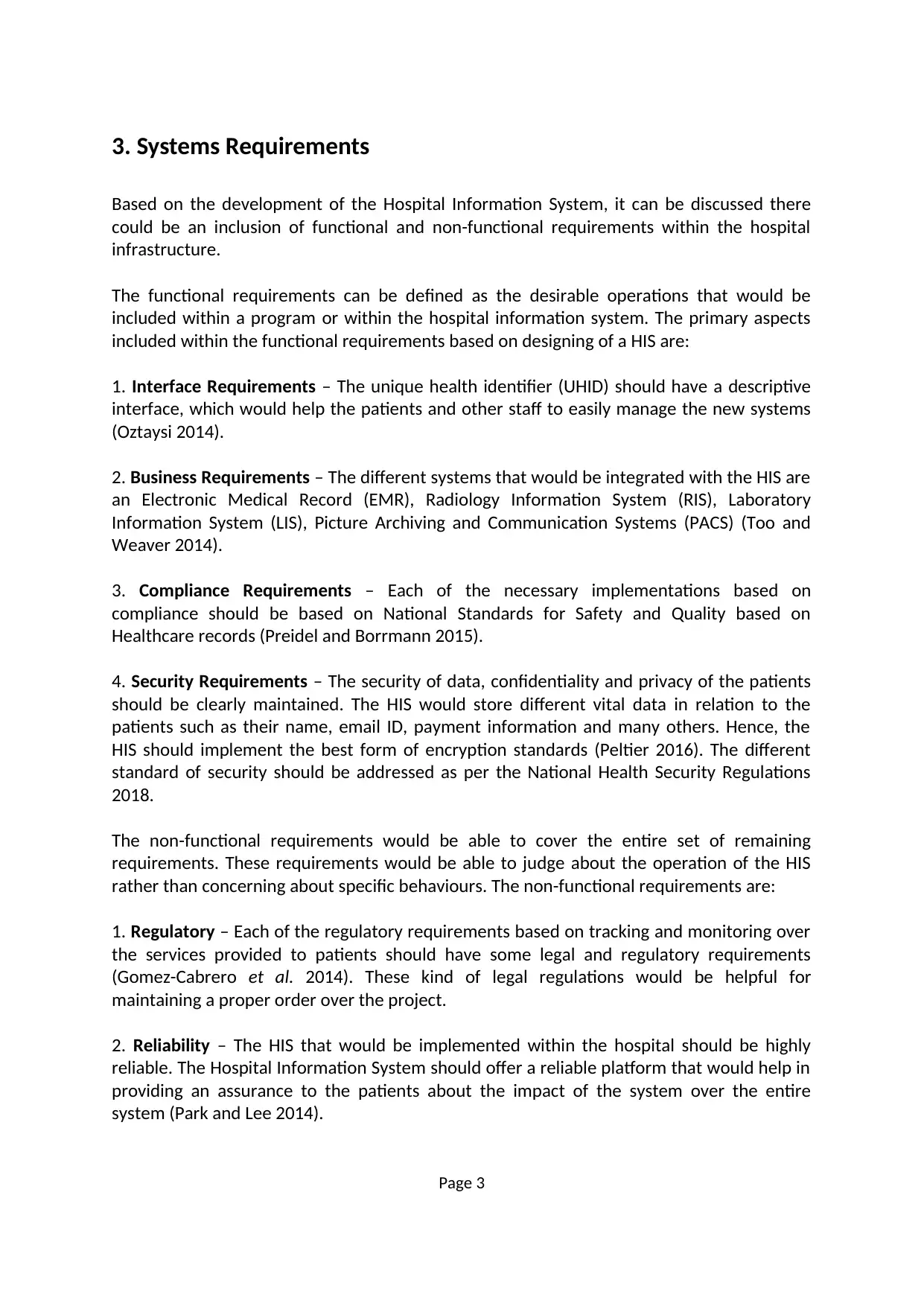
3. Systems Requirements
Based on the development of the Hospital Information System, it can be discussed there
could be an inclusion of functional and non-functional requirements within the hospital
infrastructure.
The functional requirements can be defined as the desirable operations that would be
included within a program or within the hospital information system. The primary aspects
included within the functional requirements based on designing of a HIS are:
1. Interface Requirements – The unique health identifier (UHID) should have a descriptive
interface, which would help the patients and other staff to easily manage the new systems
(Oztaysi 2014).
2. Business Requirements – The different systems that would be integrated with the HIS are
an Electronic Medical Record (EMR), Radiology Information System (RIS), Laboratory
Information System (LIS), Picture Archiving and Communication Systems (PACS) (Too and
Weaver 2014).
3. Compliance Requirements – Each of the necessary implementations based on
compliance should be based on National Standards for Safety and Quality based on
Healthcare records (Preidel and Borrmann 2015).
4. Security Requirements – The security of data, confidentiality and privacy of the patients
should be clearly maintained. The HIS would store different vital data in relation to the
patients such as their name, email ID, payment information and many others. Hence, the
HIS should implement the best form of encryption standards (Peltier 2016). The different
standard of security should be addressed as per the National Health Security Regulations
2018.
The non-functional requirements would be able to cover the entire set of remaining
requirements. These requirements would be able to judge about the operation of the HIS
rather than concerning about specific behaviours. The non-functional requirements are:
1. Regulatory – Each of the regulatory requirements based on tracking and monitoring over
the services provided to patients should have some legal and regulatory requirements
(Gomez-Cabrero et al. 2014). These kind of legal regulations would be helpful for
maintaining a proper order over the project.
2. Reliability – The HIS that would be implemented within the hospital should be highly
reliable. The Hospital Information System should offer a reliable platform that would help in
providing an assurance to the patients about the impact of the system over the entire
system (Park and Lee 2014).
Page 3
Based on the development of the Hospital Information System, it can be discussed there
could be an inclusion of functional and non-functional requirements within the hospital
infrastructure.
The functional requirements can be defined as the desirable operations that would be
included within a program or within the hospital information system. The primary aspects
included within the functional requirements based on designing of a HIS are:
1. Interface Requirements – The unique health identifier (UHID) should have a descriptive
interface, which would help the patients and other staff to easily manage the new systems
(Oztaysi 2014).
2. Business Requirements – The different systems that would be integrated with the HIS are
an Electronic Medical Record (EMR), Radiology Information System (RIS), Laboratory
Information System (LIS), Picture Archiving and Communication Systems (PACS) (Too and
Weaver 2014).
3. Compliance Requirements – Each of the necessary implementations based on
compliance should be based on National Standards for Safety and Quality based on
Healthcare records (Preidel and Borrmann 2015).
4. Security Requirements – The security of data, confidentiality and privacy of the patients
should be clearly maintained. The HIS would store different vital data in relation to the
patients such as their name, email ID, payment information and many others. Hence, the
HIS should implement the best form of encryption standards (Peltier 2016). The different
standard of security should be addressed as per the National Health Security Regulations
2018.
The non-functional requirements would be able to cover the entire set of remaining
requirements. These requirements would be able to judge about the operation of the HIS
rather than concerning about specific behaviours. The non-functional requirements are:
1. Regulatory – Each of the regulatory requirements based on tracking and monitoring over
the services provided to patients should have some legal and regulatory requirements
(Gomez-Cabrero et al. 2014). These kind of legal regulations would be helpful for
maintaining a proper order over the project.
2. Reliability – The HIS that would be implemented within the hospital should be highly
reliable. The Hospital Information System should offer a reliable platform that would help in
providing an assurance to the patients about the impact of the system over the entire
system (Park and Lee 2014).
Page 3
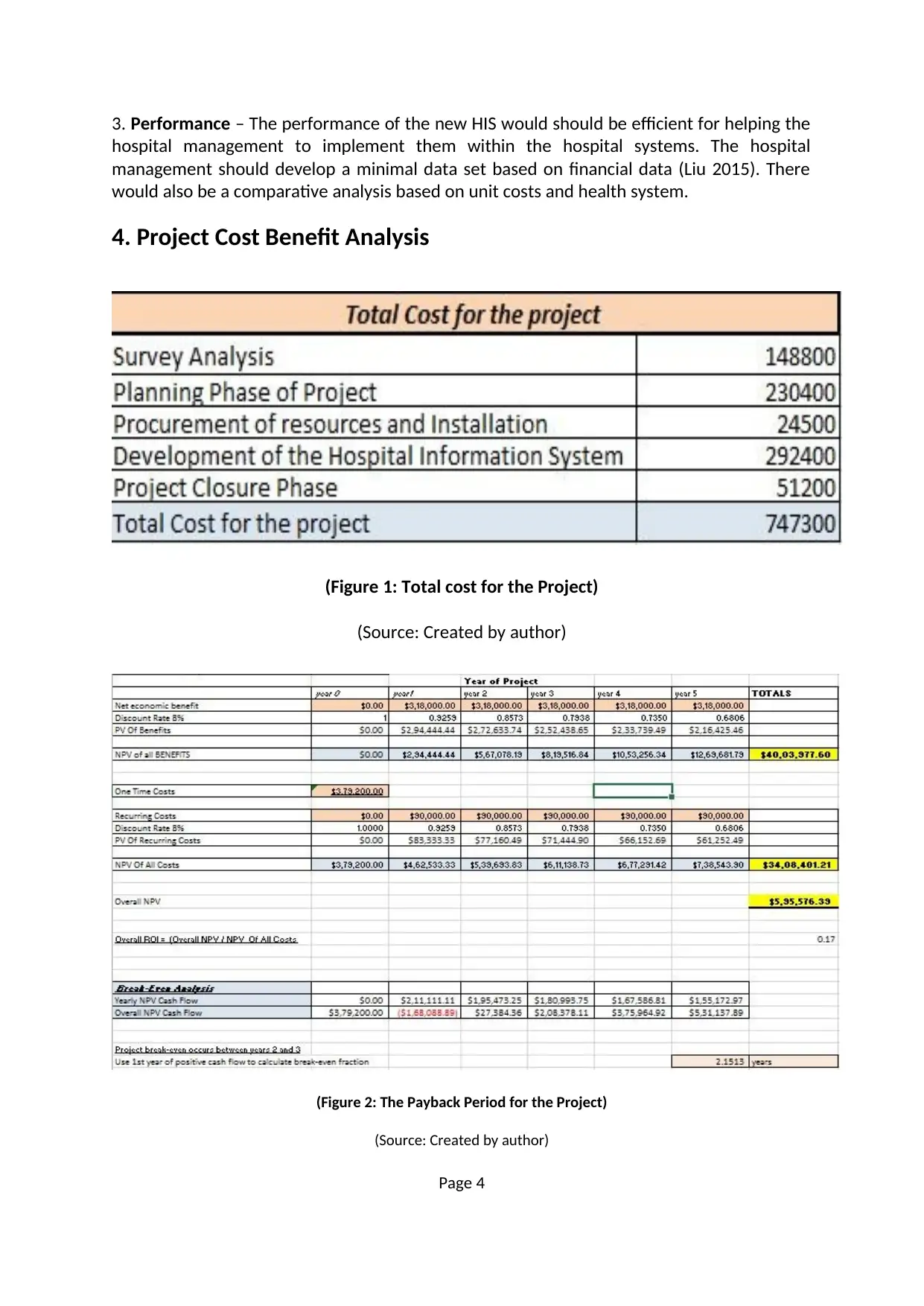
3. Performance – The performance of the new HIS would should be efficient for helping the
hospital management to implement them within the hospital systems. The hospital
management should develop a minimal data set based on financial data (Liu 2015). There
would also be a comparative analysis based on unit costs and health system.
4. Project Cost Benefit Analysis
(Figure 1: Total cost for the Project)
(Source: Created by author)
(Figure 2: The Payback Period for the Project)
(Source: Created by author)
Page 4
hospital management to implement them within the hospital systems. The hospital
management should develop a minimal data set based on financial data (Liu 2015). There
would also be a comparative analysis based on unit costs and health system.
4. Project Cost Benefit Analysis
(Figure 1: Total cost for the Project)
(Source: Created by author)
(Figure 2: The Payback Period for the Project)
(Source: Created by author)
Page 4
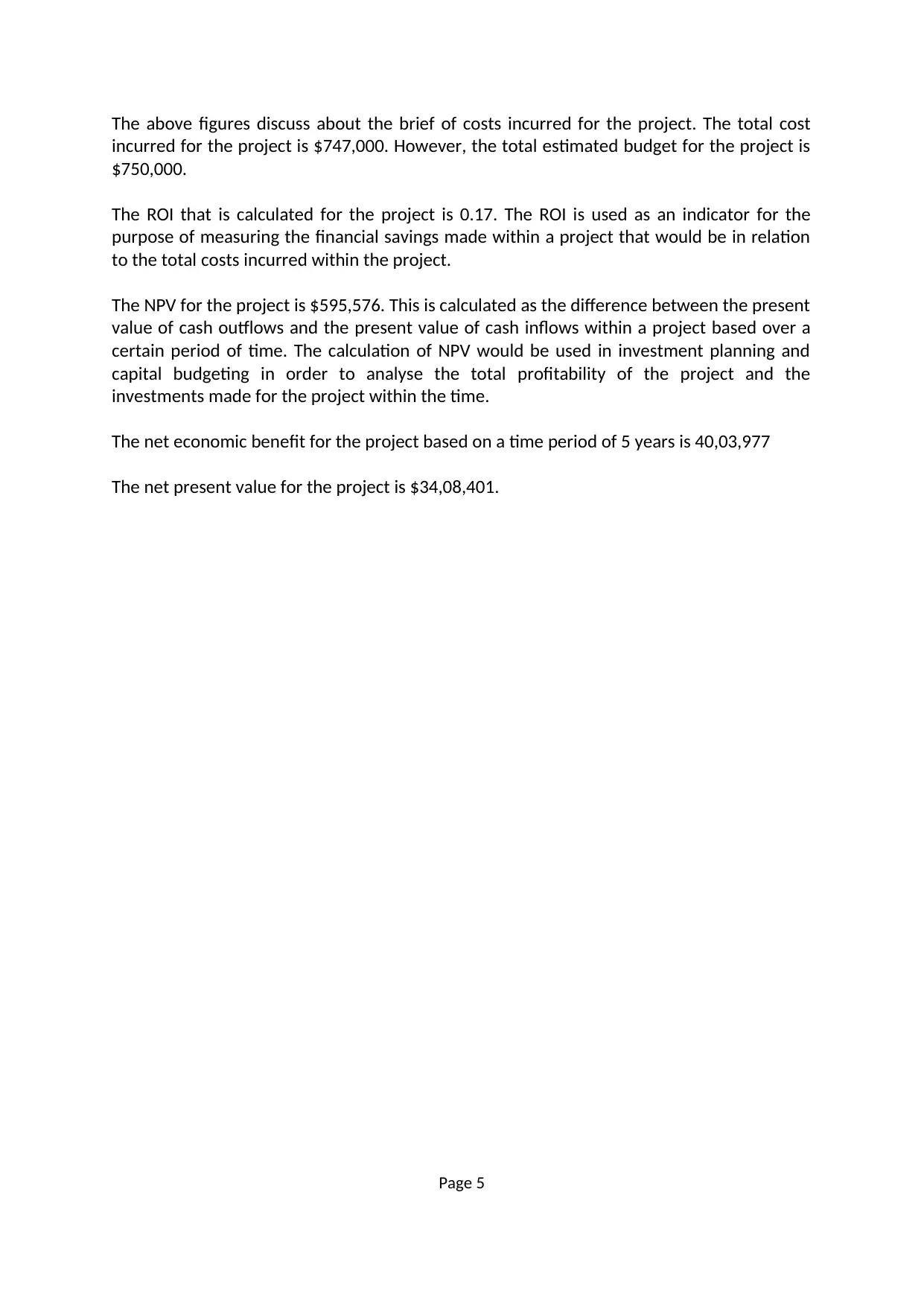
The above figures discuss about the brief of costs incurred for the project. The total cost
incurred for the project is $747,000. However, the total estimated budget for the project is
$750,000.
The ROI that is calculated for the project is 0.17. The ROI is used as an indicator for the
purpose of measuring the financial savings made within a project that would be in relation
to the total costs incurred within the project.
The NPV for the project is $595,576. This is calculated as the difference between the present
value of cash outflows and the present value of cash inflows within a project based over a
certain period of time. The calculation of NPV would be used in investment planning and
capital budgeting in order to analyse the total profitability of the project and the
investments made for the project within the time.
The net economic benefit for the project based on a time period of 5 years is 40,03,977
The net present value for the project is $34,08,401.
Page 5
incurred for the project is $747,000. However, the total estimated budget for the project is
$750,000.
The ROI that is calculated for the project is 0.17. The ROI is used as an indicator for the
purpose of measuring the financial savings made within a project that would be in relation
to the total costs incurred within the project.
The NPV for the project is $595,576. This is calculated as the difference between the present
value of cash outflows and the present value of cash inflows within a project based over a
certain period of time. The calculation of NPV would be used in investment planning and
capital budgeting in order to analyse the total profitability of the project and the
investments made for the project within the time.
The net economic benefit for the project based on a time period of 5 years is 40,03,977
The net present value for the project is $34,08,401.
Page 5
Paraphrase This Document
Need a fresh take? Get an instant paraphrase of this document with our AI Paraphraser
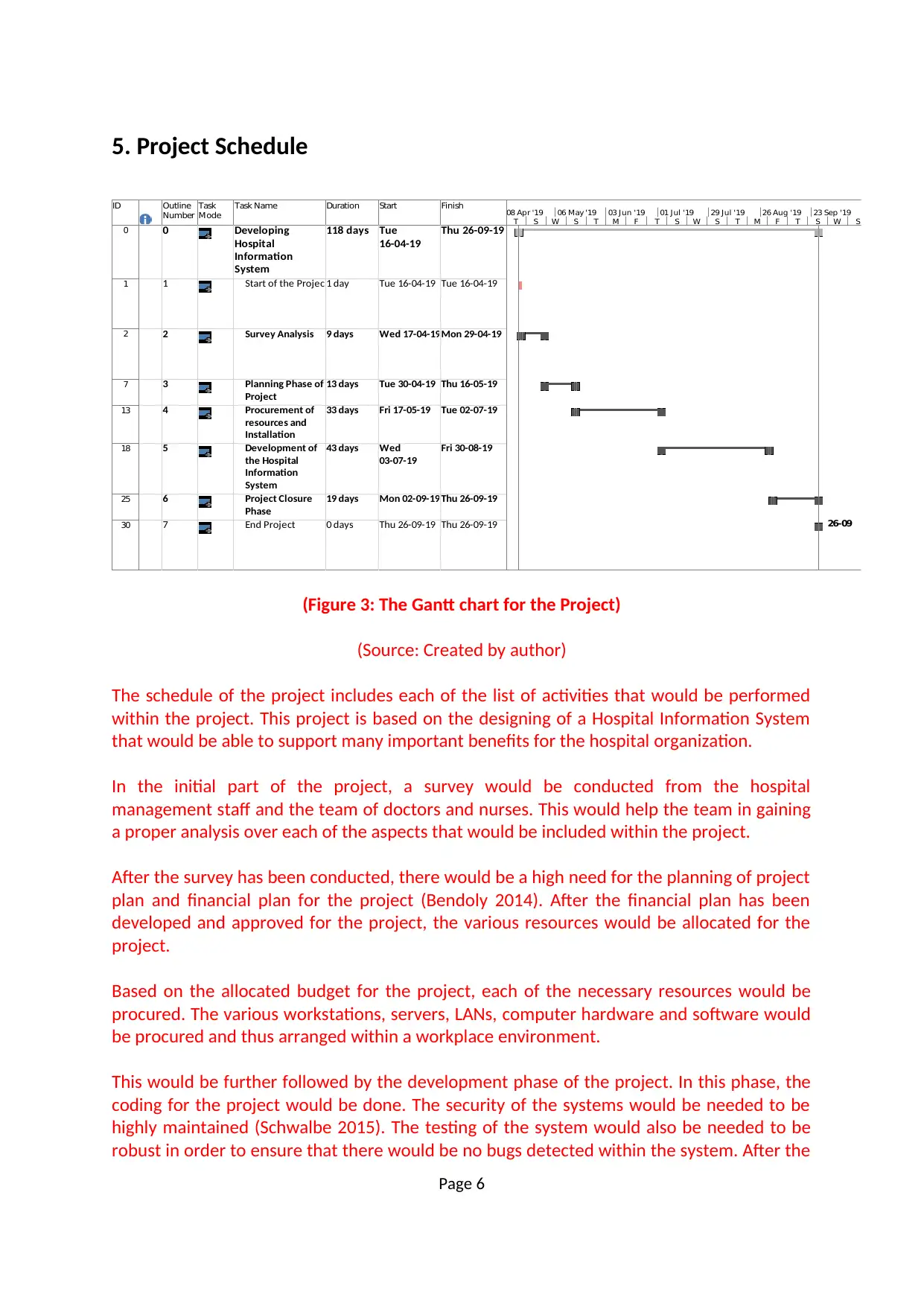
5. Project Schedule
ID Outline
Number
Task
Mode
Task Name Duration Start Finish
0 0 Developing
Hospital
Information
System
118 days Tue
16-04-19
Thu 26-09-19
1 1 Start of the Project1 day Tue 16-04-19 Tue 16-04-19
2 2 Survey Analysis 9 days Wed 17-04-19Mon 29-04-19
7 3 Planning Phase of
Project
13 days Tue 30-04-19 Thu 16-05-19
13 4 Procurement of
resources and
Installation
33 days Fri 17-05-19 Tue 02-07-19
18 5 Development of
the Hospital
Information
System
43 days Wed
03-07-19
Fri 30-08-19
25 6 Project Closure
Phase
19 days Mon 02-09-19Thu 26-09-19
30 7 End Project 0 days Thu 26-09-19 Thu 26-09-19 26-09
T S W S T M F T S W S T M F T S W S
08 Apr '19 06 May '19 03 Jun '19 01 Jul '19 29 Jul '19 26 Aug '19 23 Sep '19
(Figure 3: The Gantt chart for the Project)
(Source: Created by author)
The schedule of the project includes each of the list of activities that would be performed
within the project. This project is based on the designing of a Hospital Information System
that would be able to support many important benefits for the hospital organization.
In the initial part of the project, a survey would be conducted from the hospital
management staff and the team of doctors and nurses. This would help the team in gaining
a proper analysis over each of the aspects that would be included within the project.
After the survey has been conducted, there would be a high need for the planning of project
plan and financial plan for the project (Bendoly 2014). After the financial plan has been
developed and approved for the project, the various resources would be allocated for the
project.
Based on the allocated budget for the project, each of the necessary resources would be
procured. The various workstations, servers, LANs, computer hardware and software would
be procured and thus arranged within a workplace environment.
This would be further followed by the development phase of the project. In this phase, the
coding for the project would be done. The security of the systems would be needed to be
highly maintained (Schwalbe 2015). The testing of the system would also be needed to be
robust in order to ensure that there would be no bugs detected within the system. After the
Page 6
ID Outline
Number
Task
Mode
Task Name Duration Start Finish
0 0 Developing
Hospital
Information
System
118 days Tue
16-04-19
Thu 26-09-19
1 1 Start of the Project1 day Tue 16-04-19 Tue 16-04-19
2 2 Survey Analysis 9 days Wed 17-04-19Mon 29-04-19
7 3 Planning Phase of
Project
13 days Tue 30-04-19 Thu 16-05-19
13 4 Procurement of
resources and
Installation
33 days Fri 17-05-19 Tue 02-07-19
18 5 Development of
the Hospital
Information
System
43 days Wed
03-07-19
Fri 30-08-19
25 6 Project Closure
Phase
19 days Mon 02-09-19Thu 26-09-19
30 7 End Project 0 days Thu 26-09-19 Thu 26-09-19 26-09
T S W S T M F T S W S T M F T S W S
08 Apr '19 06 May '19 03 Jun '19 01 Jul '19 29 Jul '19 26 Aug '19 23 Sep '19
(Figure 3: The Gantt chart for the Project)
(Source: Created by author)
The schedule of the project includes each of the list of activities that would be performed
within the project. This project is based on the designing of a Hospital Information System
that would be able to support many important benefits for the hospital organization.
In the initial part of the project, a survey would be conducted from the hospital
management staff and the team of doctors and nurses. This would help the team in gaining
a proper analysis over each of the aspects that would be included within the project.
After the survey has been conducted, there would be a high need for the planning of project
plan and financial plan for the project (Bendoly 2014). After the financial plan has been
developed and approved for the project, the various resources would be allocated for the
project.
Based on the allocated budget for the project, each of the necessary resources would be
procured. The various workstations, servers, LANs, computer hardware and software would
be procured and thus arranged within a workplace environment.
This would be further followed by the development phase of the project. In this phase, the
coding for the project would be done. The security of the systems would be needed to be
highly maintained (Schwalbe 2015). The testing of the system would also be needed to be
robust in order to ensure that there would be no bugs detected within the system. After the
Page 6

systems have been properly tested, a quality analyst would analyse the entire project and
also assure the hospital management about the success criteria of the project and its
development criteria.
After the completion of the project, the documentation of the project would be needed to
be done. The documentation of the project would help the hospital organisation to keep a
track over the entire project. This would also be helpful for performing future maintenance
of the hospital information system.
Page 7
also assure the hospital management about the success criteria of the project and its
development criteria.
After the completion of the project, the documentation of the project would be needed to
be done. The documentation of the project would help the hospital organisation to keep a
track over the entire project. This would also be helpful for performing future maintenance
of the hospital information system.
Page 7
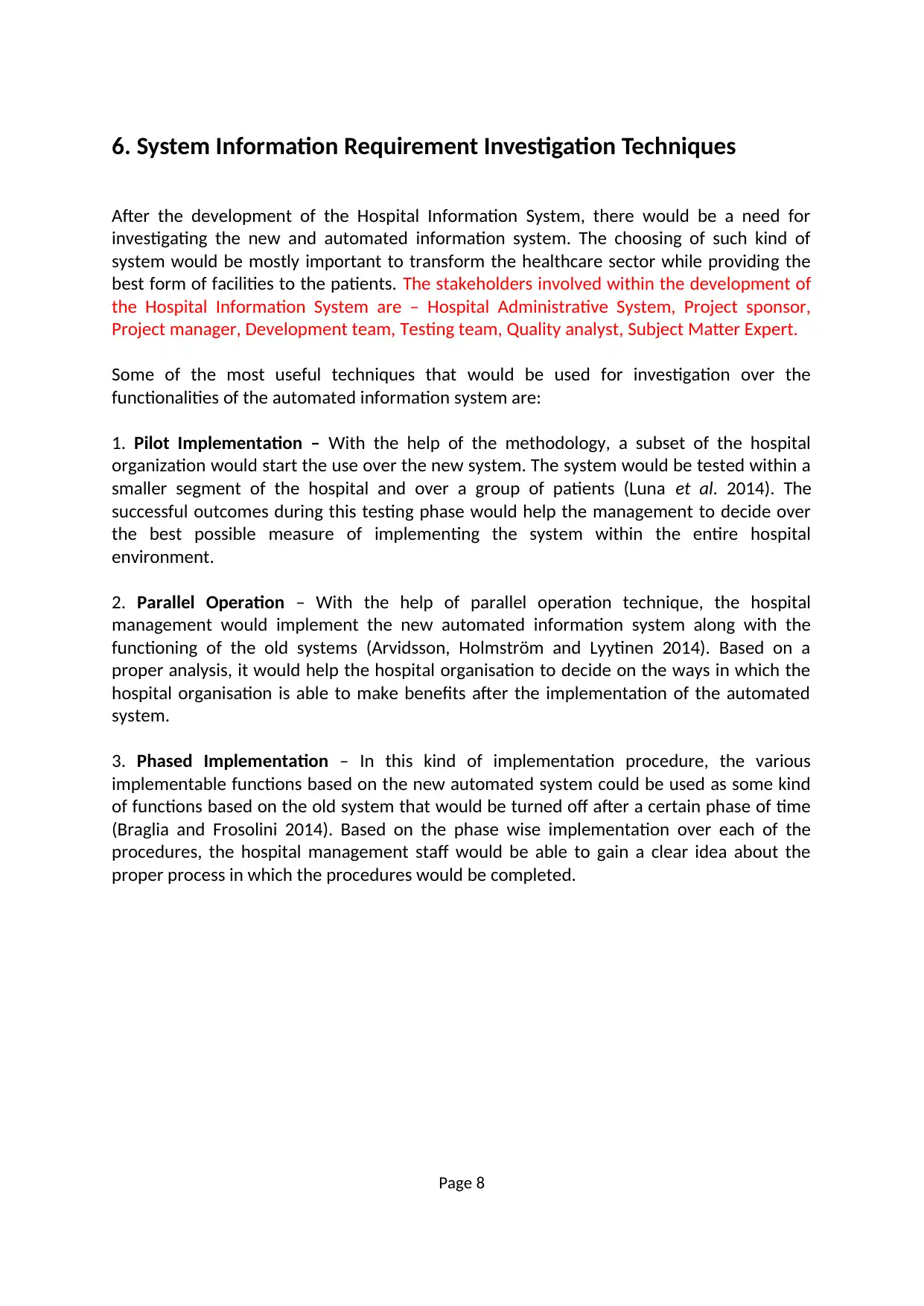
6. System Information Requirement Investigation Techniques
After the development of the Hospital Information System, there would be a need for
investigating the new and automated information system. The choosing of such kind of
system would be mostly important to transform the healthcare sector while providing the
best form of facilities to the patients. The stakeholders involved within the development of
the Hospital Information System are – Hospital Administrative System, Project sponsor,
Project manager, Development team, Testing team, Quality analyst, Subject Matter Expert.
Some of the most useful techniques that would be used for investigation over the
functionalities of the automated information system are:
1. Pilot Implementation – With the help of the methodology, a subset of the hospital
organization would start the use over the new system. The system would be tested within a
smaller segment of the hospital and over a group of patients (Luna et al. 2014). The
successful outcomes during this testing phase would help the management to decide over
the best possible measure of implementing the system within the entire hospital
environment.
2. Parallel Operation – With the help of parallel operation technique, the hospital
management would implement the new automated information system along with the
functioning of the old systems (Arvidsson, Holmström and Lyytinen 2014). Based on a
proper analysis, it would help the hospital organisation to decide on the ways in which the
hospital organisation is able to make benefits after the implementation of the automated
system.
3. Phased Implementation – In this kind of implementation procedure, the various
implementable functions based on the new automated system could be used as some kind
of functions based on the old system that would be turned off after a certain phase of time
(Braglia and Frosolini 2014). Based on the phase wise implementation over each of the
procedures, the hospital management staff would be able to gain a clear idea about the
proper process in which the procedures would be completed.
Page 8
After the development of the Hospital Information System, there would be a need for
investigating the new and automated information system. The choosing of such kind of
system would be mostly important to transform the healthcare sector while providing the
best form of facilities to the patients. The stakeholders involved within the development of
the Hospital Information System are – Hospital Administrative System, Project sponsor,
Project manager, Development team, Testing team, Quality analyst, Subject Matter Expert.
Some of the most useful techniques that would be used for investigation over the
functionalities of the automated information system are:
1. Pilot Implementation – With the help of the methodology, a subset of the hospital
organization would start the use over the new system. The system would be tested within a
smaller segment of the hospital and over a group of patients (Luna et al. 2014). The
successful outcomes during this testing phase would help the management to decide over
the best possible measure of implementing the system within the entire hospital
environment.
2. Parallel Operation – With the help of parallel operation technique, the hospital
management would implement the new automated information system along with the
functioning of the old systems (Arvidsson, Holmström and Lyytinen 2014). Based on a
proper analysis, it would help the hospital organisation to decide on the ways in which the
hospital organisation is able to make benefits after the implementation of the automated
system.
3. Phased Implementation – In this kind of implementation procedure, the various
implementable functions based on the new automated system could be used as some kind
of functions based on the old system that would be turned off after a certain phase of time
(Braglia and Frosolini 2014). Based on the phase wise implementation over each of the
procedures, the hospital management staff would be able to gain a clear idea about the
proper process in which the procedures would be completed.
Page 8
Secure Best Marks with AI Grader
Need help grading? Try our AI Grader for instant feedback on your assignments.
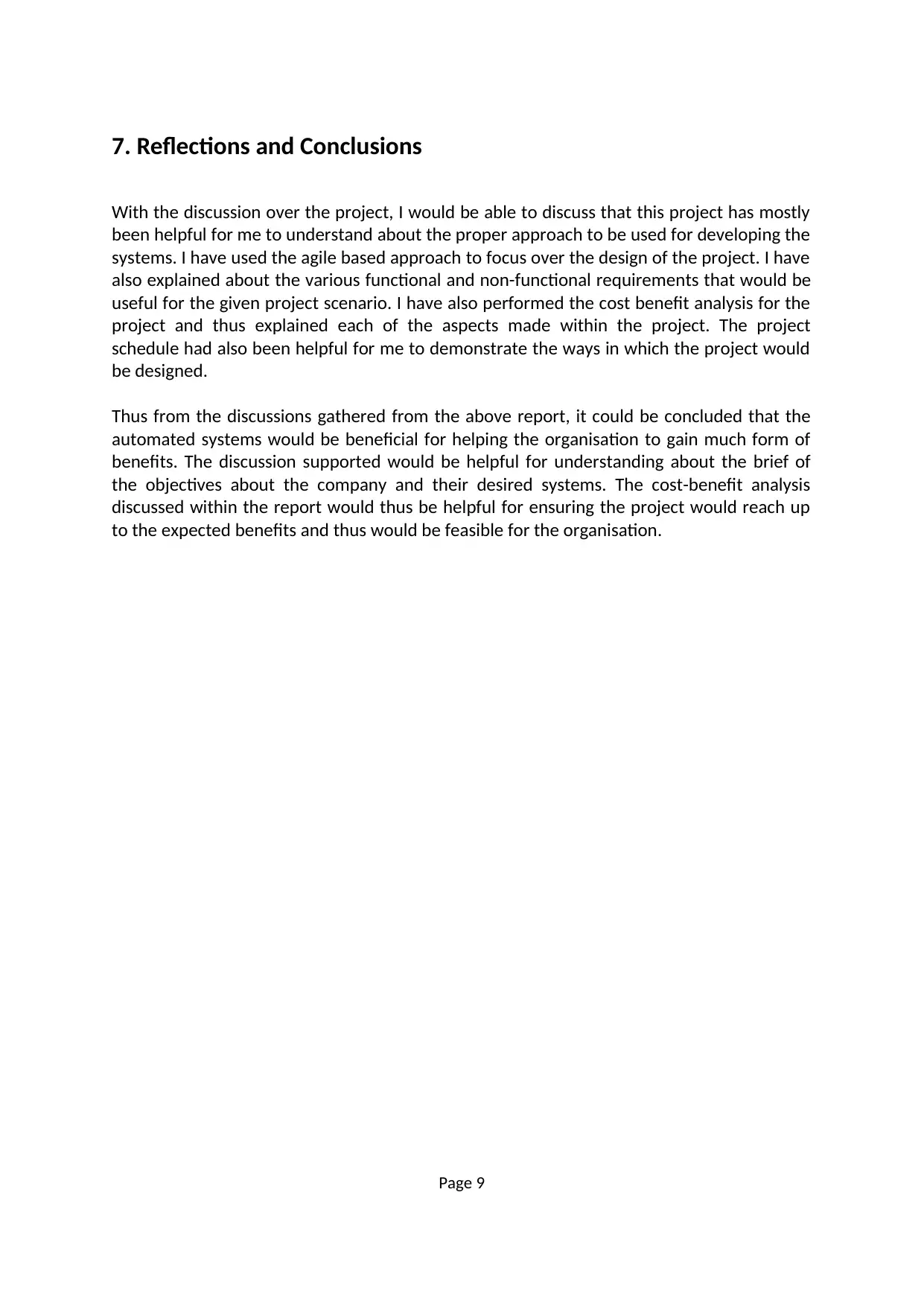
7. Reflections and Conclusions
With the discussion over the project, I would be able to discuss that this project has mostly
been helpful for me to understand about the proper approach to be used for developing the
systems. I have used the agile based approach to focus over the design of the project. I have
also explained about the various functional and non-functional requirements that would be
useful for the given project scenario. I have also performed the cost benefit analysis for the
project and thus explained each of the aspects made within the project. The project
schedule had also been helpful for me to demonstrate the ways in which the project would
be designed.
Thus from the discussions gathered from the above report, it could be concluded that the
automated systems would be beneficial for helping the organisation to gain much form of
benefits. The discussion supported would be helpful for understanding about the brief of
the objectives about the company and their desired systems. The cost-benefit analysis
discussed within the report would thus be helpful for ensuring the project would reach up
to the expected benefits and thus would be feasible for the organisation.
Page 9
With the discussion over the project, I would be able to discuss that this project has mostly
been helpful for me to understand about the proper approach to be used for developing the
systems. I have used the agile based approach to focus over the design of the project. I have
also explained about the various functional and non-functional requirements that would be
useful for the given project scenario. I have also performed the cost benefit analysis for the
project and thus explained each of the aspects made within the project. The project
schedule had also been helpful for me to demonstrate the ways in which the project would
be designed.
Thus from the discussions gathered from the above report, it could be concluded that the
automated systems would be beneficial for helping the organisation to gain much form of
benefits. The discussion supported would be helpful for understanding about the brief of
the objectives about the company and their desired systems. The cost-benefit analysis
discussed within the report would thus be helpful for ensuring the project would reach up
to the expected benefits and thus would be feasible for the organisation.
Page 9
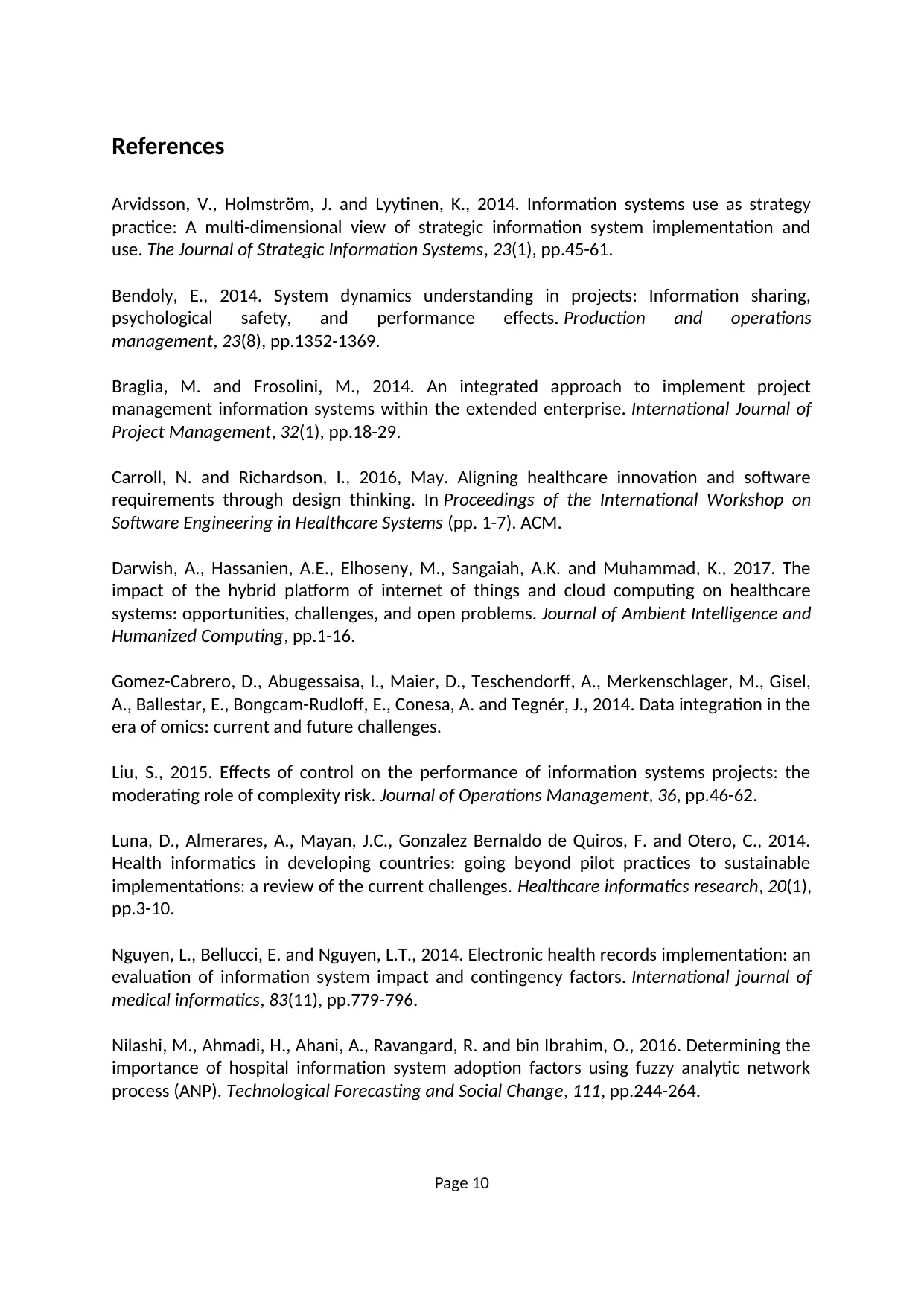
References
Arvidsson, V., Holmström, J. and Lyytinen, K., 2014. Information systems use as strategy
practice: A multi-dimensional view of strategic information system implementation and
use. The Journal of Strategic Information Systems, 23(1), pp.45-61.
Bendoly, E., 2014. System dynamics understanding in projects: Information sharing,
psychological safety, and performance effects. Production and operations
management, 23(8), pp.1352-1369.
Braglia, M. and Frosolini, M., 2014. An integrated approach to implement project
management information systems within the extended enterprise. International Journal of
Project Management, 32(1), pp.18-29.
Carroll, N. and Richardson, I., 2016, May. Aligning healthcare innovation and software
requirements through design thinking. In Proceedings of the International Workshop on
Software Engineering in Healthcare Systems (pp. 1-7). ACM.
Darwish, A., Hassanien, A.E., Elhoseny, M., Sangaiah, A.K. and Muhammad, K., 2017. The
impact of the hybrid platform of internet of things and cloud computing on healthcare
systems: opportunities, challenges, and open problems. Journal of Ambient Intelligence and
Humanized Computing, pp.1-16.
Gomez-Cabrero, D., Abugessaisa, I., Maier, D., Teschendorff, A., Merkenschlager, M., Gisel,
A., Ballestar, E., Bongcam-Rudloff, E., Conesa, A. and Tegnér, J., 2014. Data integration in the
era of omics: current and future challenges.
Liu, S., 2015. Effects of control on the performance of information systems projects: the
moderating role of complexity risk. Journal of Operations Management, 36, pp.46-62.
Luna, D., Almerares, A., Mayan, J.C., Gonzalez Bernaldo de Quiros, F. and Otero, C., 2014.
Health informatics in developing countries: going beyond pilot practices to sustainable
implementations: a review of the current challenges. Healthcare informatics research, 20(1),
pp.3-10.
Nguyen, L., Bellucci, E. and Nguyen, L.T., 2014. Electronic health records implementation: an
evaluation of information system impact and contingency factors. International journal of
medical informatics, 83(11), pp.779-796.
Nilashi, M., Ahmadi, H., Ahani, A., Ravangard, R. and bin Ibrahim, O., 2016. Determining the
importance of hospital information system adoption factors using fuzzy analytic network
process (ANP). Technological Forecasting and Social Change, 111, pp.244-264.
Page 10
Arvidsson, V., Holmström, J. and Lyytinen, K., 2014. Information systems use as strategy
practice: A multi-dimensional view of strategic information system implementation and
use. The Journal of Strategic Information Systems, 23(1), pp.45-61.
Bendoly, E., 2014. System dynamics understanding in projects: Information sharing,
psychological safety, and performance effects. Production and operations
management, 23(8), pp.1352-1369.
Braglia, M. and Frosolini, M., 2014. An integrated approach to implement project
management information systems within the extended enterprise. International Journal of
Project Management, 32(1), pp.18-29.
Carroll, N. and Richardson, I., 2016, May. Aligning healthcare innovation and software
requirements through design thinking. In Proceedings of the International Workshop on
Software Engineering in Healthcare Systems (pp. 1-7). ACM.
Darwish, A., Hassanien, A.E., Elhoseny, M., Sangaiah, A.K. and Muhammad, K., 2017. The
impact of the hybrid platform of internet of things and cloud computing on healthcare
systems: opportunities, challenges, and open problems. Journal of Ambient Intelligence and
Humanized Computing, pp.1-16.
Gomez-Cabrero, D., Abugessaisa, I., Maier, D., Teschendorff, A., Merkenschlager, M., Gisel,
A., Ballestar, E., Bongcam-Rudloff, E., Conesa, A. and Tegnér, J., 2014. Data integration in the
era of omics: current and future challenges.
Liu, S., 2015. Effects of control on the performance of information systems projects: the
moderating role of complexity risk. Journal of Operations Management, 36, pp.46-62.
Luna, D., Almerares, A., Mayan, J.C., Gonzalez Bernaldo de Quiros, F. and Otero, C., 2014.
Health informatics in developing countries: going beyond pilot practices to sustainable
implementations: a review of the current challenges. Healthcare informatics research, 20(1),
pp.3-10.
Nguyen, L., Bellucci, E. and Nguyen, L.T., 2014. Electronic health records implementation: an
evaluation of information system impact and contingency factors. International journal of
medical informatics, 83(11), pp.779-796.
Nilashi, M., Ahmadi, H., Ahani, A., Ravangard, R. and bin Ibrahim, O., 2016. Determining the
importance of hospital information system adoption factors using fuzzy analytic network
process (ANP). Technological Forecasting and Social Change, 111, pp.244-264.
Page 10
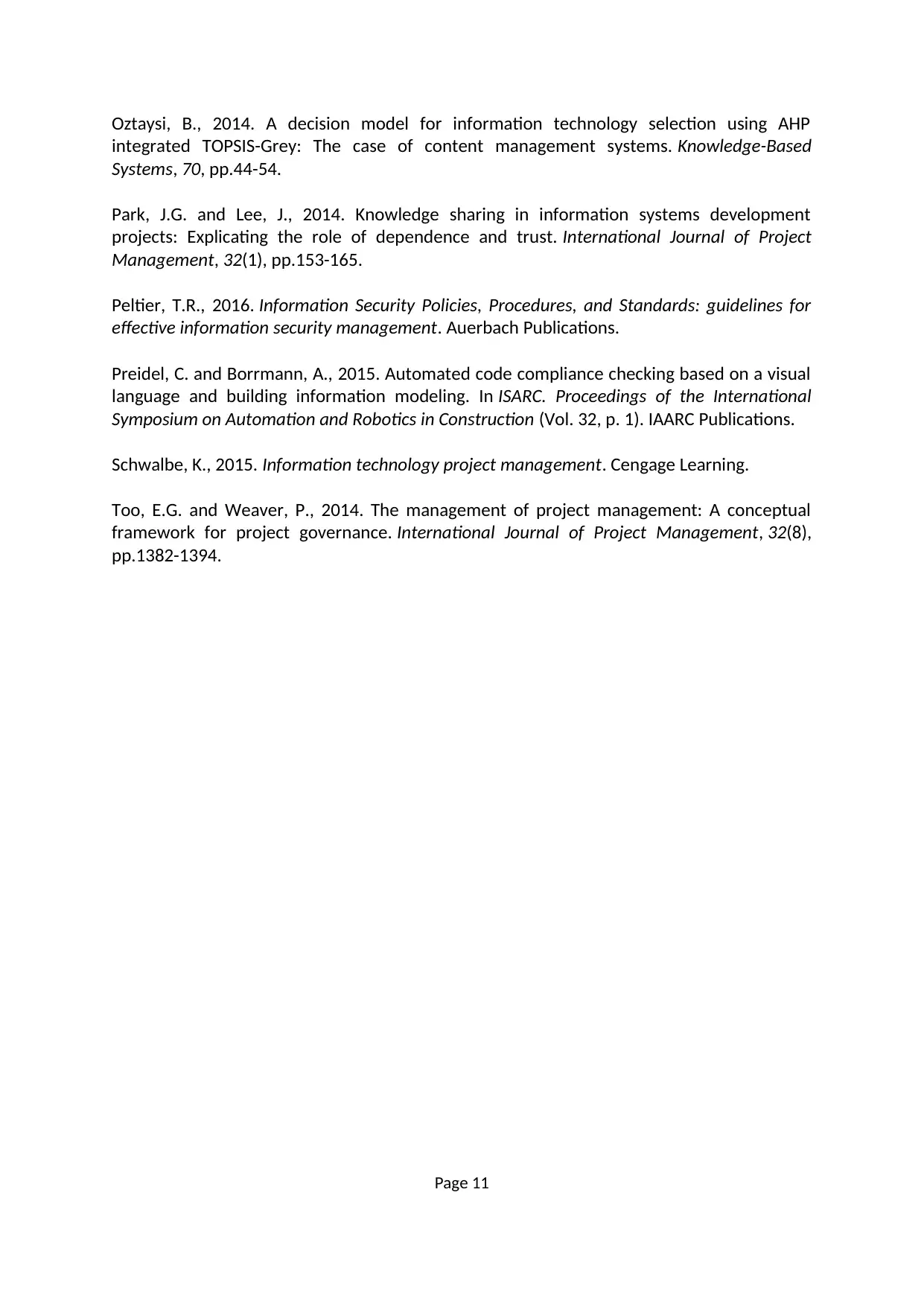
Oztaysi, B., 2014. A decision model for information technology selection using AHP
integrated TOPSIS-Grey: The case of content management systems. Knowledge-Based
Systems, 70, pp.44-54.
Park, J.G. and Lee, J., 2014. Knowledge sharing in information systems development
projects: Explicating the role of dependence and trust. International Journal of Project
Management, 32(1), pp.153-165.
Peltier, T.R., 2016. Information Security Policies, Procedures, and Standards: guidelines for
effective information security management. Auerbach Publications.
Preidel, C. and Borrmann, A., 2015. Automated code compliance checking based on a visual
language and building information modeling. In ISARC. Proceedings of the International
Symposium on Automation and Robotics in Construction (Vol. 32, p. 1). IAARC Publications.
Schwalbe, K., 2015. Information technology project management. Cengage Learning.
Too, E.G. and Weaver, P., 2014. The management of project management: A conceptual
framework for project governance. International Journal of Project Management, 32(8),
pp.1382-1394.
Page 11
integrated TOPSIS-Grey: The case of content management systems. Knowledge-Based
Systems, 70, pp.44-54.
Park, J.G. and Lee, J., 2014. Knowledge sharing in information systems development
projects: Explicating the role of dependence and trust. International Journal of Project
Management, 32(1), pp.153-165.
Peltier, T.R., 2016. Information Security Policies, Procedures, and Standards: guidelines for
effective information security management. Auerbach Publications.
Preidel, C. and Borrmann, A., 2015. Automated code compliance checking based on a visual
language and building information modeling. In ISARC. Proceedings of the International
Symposium on Automation and Robotics in Construction (Vol. 32, p. 1). IAARC Publications.
Schwalbe, K., 2015. Information technology project management. Cengage Learning.
Too, E.G. and Weaver, P., 2014. The management of project management: A conceptual
framework for project governance. International Journal of Project Management, 32(8),
pp.1382-1394.
Page 11
1 out of 13
Related Documents
Your All-in-One AI-Powered Toolkit for Academic Success.
+13062052269
info@desklib.com
Available 24*7 on WhatsApp / Email
![[object Object]](/_next/static/media/star-bottom.7253800d.svg)
Unlock your academic potential
© 2024 | Zucol Services PVT LTD | All rights reserved.





